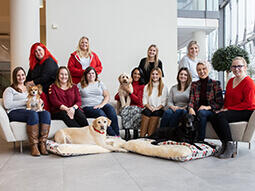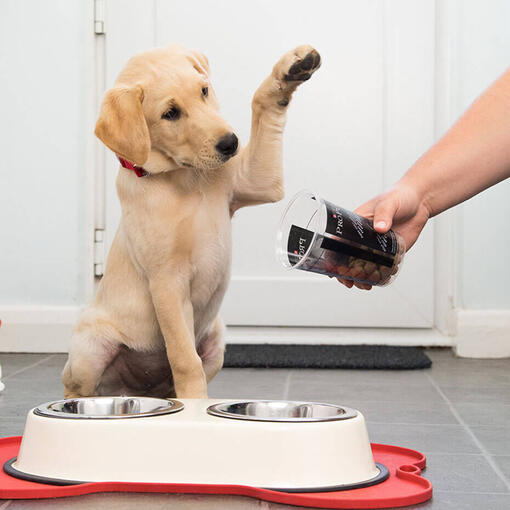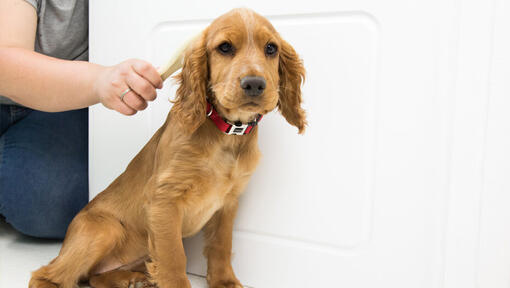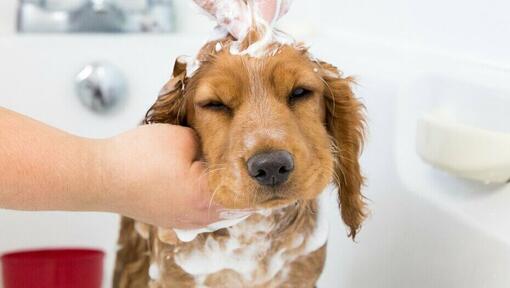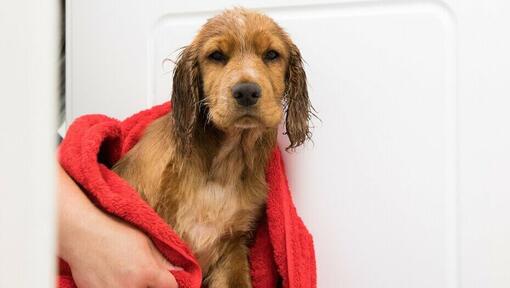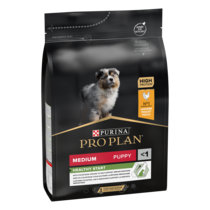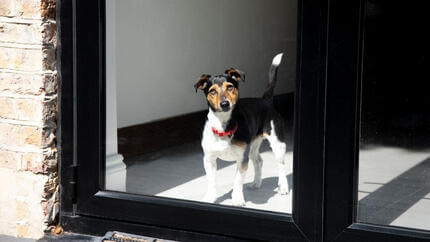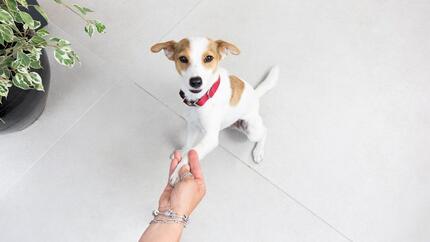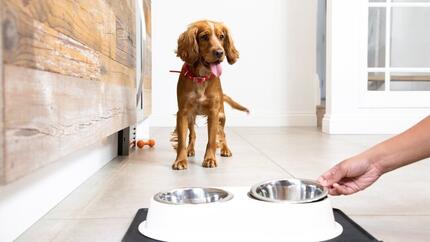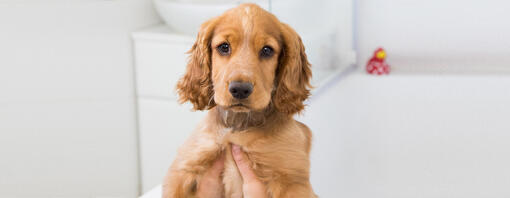

Are you getting ready to bathe your puppy for the first time? Here is everything you need to know.
What you will need for your puppy’s first bath
Let’s start easy with a shopping list. Here are the must-haves of puppy bathing time.
- Table
- Towel
- Suitable puppy brush
- Hair dryer
- Dog bath or other suitable container
- Puppy shampoo
- A treat
Steps for bathing a puppy
When your puppy arrives home for the first time, it is beneficial to give them a bath in order to let them start their new experience fresh and clean. Here is a step-by-step guide for bathing your puppy without any unnecessary complications:
1. Place the puppy on a table
The table has to be specifically designated for the job. In placing the puppy in this elevated, unfamiliar spot, you will help them understand that you are not playing. This will help you handle bathtime safely and comfortably. Put a towel on the table to ensure your puppy doesn’t slip off. It will also absorb excess water.
2. Gently brush your puppy
Before proceeding to bathe them, start brushing your puppy slowly as this will calm them down. Simple movements with an appropriate brush will also remove dirt from their coat. Brush your dog to help remove matting, knots and foreign bodies.
3. Turn the hairdryer on
Leave the dryer near the table to help your puppy get used to the noise of the appliance. The idea is to get your puppy used to this situation while making this a nurturing and joyful experience.
4. Place your puppy in the bath
Proceed to place your puppy in a decent sized container or dog/puppy bath, which should be inside the bathtub.
5. Soak the puppy in warm water
Using the showerhead, soak your puppy in warm water, always making sure that it is not too hot or cold. Whether you’re indoors or out, use lukewarm water and let it run until it reaches your dog’s knee level. Don’t overfill the tub, as this could make your dog panic.
6. Prepare the shampoo
Prepare the puppy shampoo by mixing it with water. Using a soft sponge, spread the shampoo evenly on its fur, taking care to avoid the eyes. During the puppy bath, use a jug or shower spray to wet their coat and apply a small amount of shampoo.
Always read the label as some shampoos need to be diluted while medicated shampoos may need to be left for a few minutes to activate. Lather their body all over, including the tail, underside and neck, taking particular care to avoid their eyes and ears.
7. Gently start scrubbing
The scrubbing will not only wash and massage the puppy, but will also get them used to being handled.
8. Rinse
It is important to rinse the fur of all shampoo once you have finished bathing your puppy. When they’re ready to be rinsed, use one hand to operate the shower nozzle or pour the jug of warm, clean water and the other hand to hold a flannel to protect their eyes and ears. If your dog has loose facial skin or long droopy ears, get between the skin folds with baby wipes or a damp flannel with no excess water and definitely no soap. You might need to do this regularly, even daily, using a damp cloth.
9. Dry
Moving on to drying! When they come out of the bath, your puppy will automatically want to shake themselves. Your bathroom might get a bit wet, but it’s their instinctive way of getting rid of most of the water.
When they have done this, start with a vigorous round with the towel. While you are drying them, rest them on your stomach and keep them still with one hand to ensure they feel safe.
With the hairdryer, apply warm air to the fur, starting from the tail to not scare them. Try and avoid blowing air directly on their nose and ears. Make sure your puppy is thoroughly dry, particularly the back and under the legs.
10. Brush
Once you have finished bathing your puppy and drying them off, place your puppy on the table again for a couple of seconds and brush and stroke them.
11. Treat time!
Last but not least, give your puppy a biscuit as a reward!
Puppy bathing tips:
- Make sure the dryer isn’t too close to their skin, is not directed into their eyes and keep the airflow warm but not hot.
- When dogs get wet their natural response is to roll and rub their heads, necks and bodies on any available ground, including grass. To stop them getting dirty as soon as they’ve just been cleaned, lay down some dog towels on the bathroom floor or the lawn and encourage your puppy to use these instead.
- Small and thin breeds get cold easily, so keep your puppy in a warm room until they’re completely dry.
- It is very important to rinse the shampoo and/or conditioner thoroughly as residue can make their coat itchy or dry.
- Clean their inner ears using a specific dog ear cleaner (available from pet shops or your vets) but never put anything in their ear canals such as cotton wool or a cotton bud.
- If your dog shows signs of nervousness, especially if it’s their first bath, offer them plenty of praise and reassurance throughout.
How to get your puppy used to the hairdryer
If your puppy coat is very long or thick, they can take a surprisingly long time to dry so you may want to use a hairdryer. Hairdryers can be quite frightening for a dog so reassure them and reward good behaviour.
If your puppy is likely to need their hair dried but isn’t used to it, start introducing it from an early age, initially just using the dryer to make noise in the room, before moving it towards the dog with lots of soothing encouragement.
And that’s it – it’s as easy as that to bathe your dog! For more tips on helping your puppy settle in, check our in-depth article and if you need some puppy training tips, we’ve put together an impressive list.
